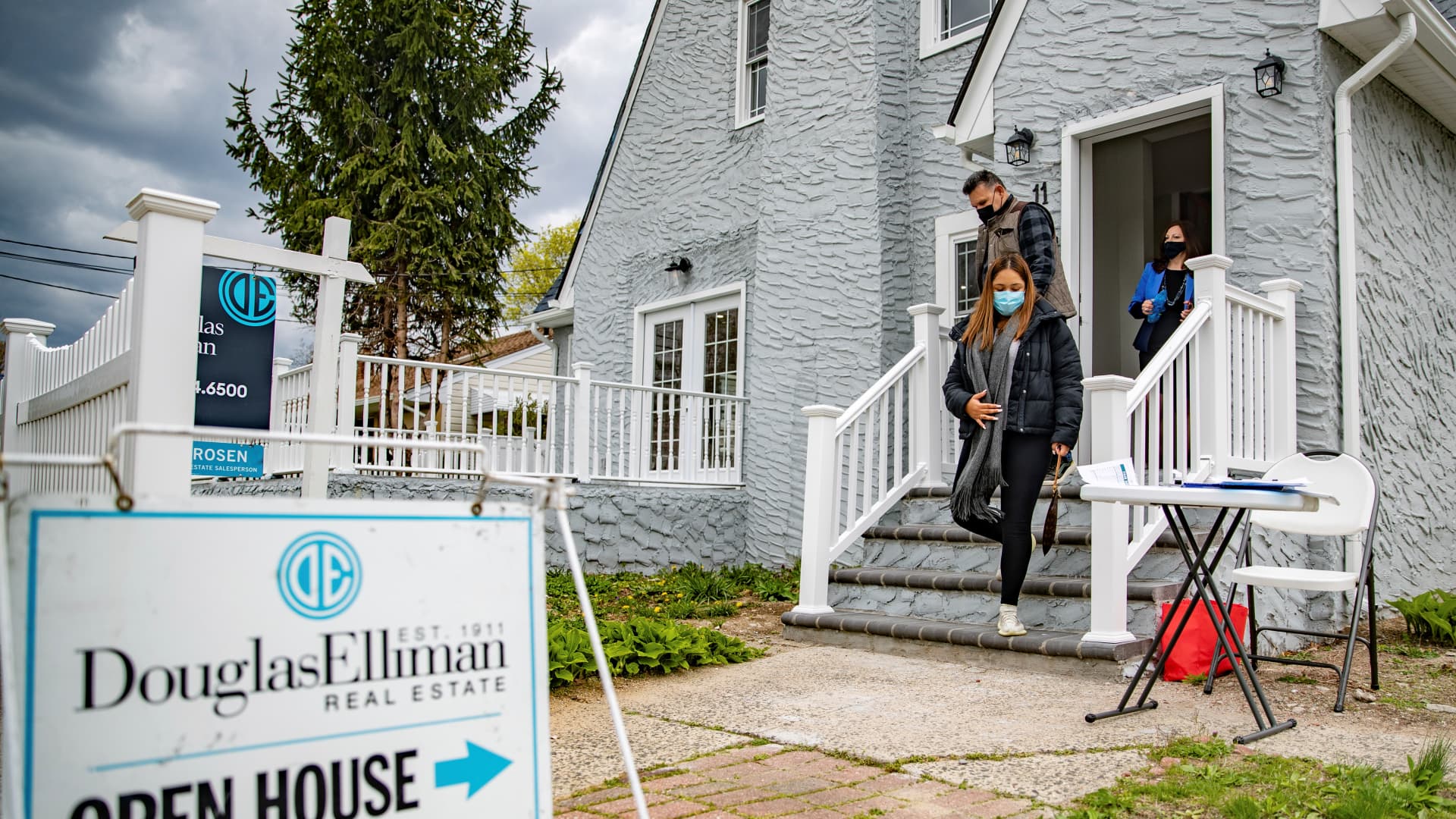A real estate agent stands in the doorway as Giovani and Nicole Quiroz of Brooklyn, New York visit an open house in West Hempstead, New York.
Raychel Brightman | Newsday LLC | Newsday | Getty Images
After dropping to record lows in 2020 and 2021, mortgage rates are back up. Way up. While the past few weeks saw a reversal in the surge, at near 6%, current mortgage rates are still almost double what some homebuyers were paying in recent years. With soaring inflation and the possibility of further rate increases, would-be homebuyers may be looking for ways to lower their rates.
Here are five possible money-saving options.
1. Try to boost your credit score
Consumers may be able to improve their credit score in less than a month, said Daniel Rodriguez, chief operating officer at the wealth management firm Hill Wealth Strategies. Start by checking for discrepancies on your credit report that could make your debt situation appear worse than it actually is, he said. Also, if you have the cash, pay down your debts to reduce your debt-to-credit ratio.
Once you’ve taken positive steps to improve your credit, consider asking your lender to initiate a process called a rapid rescore as a way to get positive changes to your credit updated quickly — typically within a week as opposed to 30 to 60 days.
“Anything helps. Even if it’s only five points, it could make a big difference,” said John W. Mallett, president of MainStreet Mortgage, a mortgage broker in Westlake Village, California.
2. Comparison shop
Compare offerings among a variety of lenders and products. A local bank or credit union where you do significant business could offer more competitive rates than a large bank you’ve never worked with before. You could also try a mortgage broker to compare rates from several different lenders.
A mortgage bank, which specializes in home loan products, could be another option. Before reaching out it’s good to get a baseline idea of what’s available using online tools such as Bankrate.com or NerdWallet.
3. Consider paying points
Mortgage points are fees a borrower pays to a lender in exchange for a reduced interest rate. Each point equals 1% of the total loan amount.
Here’s a hypothetical example for a $200,000 loan taking into account principal and interest only. With zero points and an APR of 4.5%, the monthly payment would be $1,013.37, according to an example from Bank of America. With one point, the buyer would pay $2,000 for an APR of 4.25% and a monthly payment of $983.88. The total savings on a 30-year-loan would be $10,616.40, assuming the buyer owns the home for the full term and doesn’t refinance. With two points, the buyer would pay $4,000 for an APR of 4% and a monthly payment of $954.83. The total savings on that loan would be $21,074.40, again assuming the buyer owns the home for the full 30 years without refinancing.
More from Invest in You:
The big risks in buying a house sight unseen
5 steps you can take now to prepare your finances for a recession
Here’s how to adjust your housing budget amid rising mortgage rates
Be sure to crunch the numbers, taking into account factors such as how long you expect to own the home. With the 2-point option, for instance, you’d be saving $58.54 per month, compared with the no-point loan option. But because of the $4,000 upfront cost, it would take you 68 months to break even, according to Bank of America.
If you are going to keep the loan for the long-term, you could be better off paying points to get the lower rate, Mallett said.
4. Make a larger down payment
Instead of putting 20% down, consider putting down more additional cash upfront. This strategy will reduce a buyer’s loan-to-value ratio and potentially decrease lenders’ risks, said John Keratsis, president and chief executive of mortgage lender Deephaven Mortgage. “This may make borrowers more favorable candidates for a lower-rate loan.”
How much lower depends on the lender and the product, but it could be somewhere up to 1%, said Josip Rupena, chief executive of Milo, a financial technology company that offers home loans.
Of course, there can be downsides to this strategy as well. You need to make sure you have the cash to do this, without depleting needed reserves.
5. Consider other loan types
One option is an adjustable-rate mortgage, or ARM.
As of July 11, the average APR for a 30-year fixed mortgage was 5.75%, according to a national survey by Bankrate. By contrast, Bankrate lists the marketplace average APR on a 5/1 ARM, meaning the rate stays the same for five years, as 5.53%. The average APR on a 7/1 ARM, where the introductory rate stays constant for seven years, is 4.98%, Bankrate said.
Another option could be an interest-only fixed-rate mortgage that is amortized over 30 years and allows the borrower to pay interest-only at the onset, say for 10 years. You’ll pay more over the life of the loan, but this could be an especially attractive option if you plan to keep the property for less than 10 years, Rupena said.
When weighing the economics of these loan types, how long you plan to keep a property is an important consideration prospective buyers should weigh carefully, he said.
SIGN UP: Money 101 is an 8-week learning course to financial freedom, delivered weekly to your inbox. For the Spanish version Dinero 101, click here.
Disclosure: NBCUniversal and Comcast Ventures are investors in Acorns.

